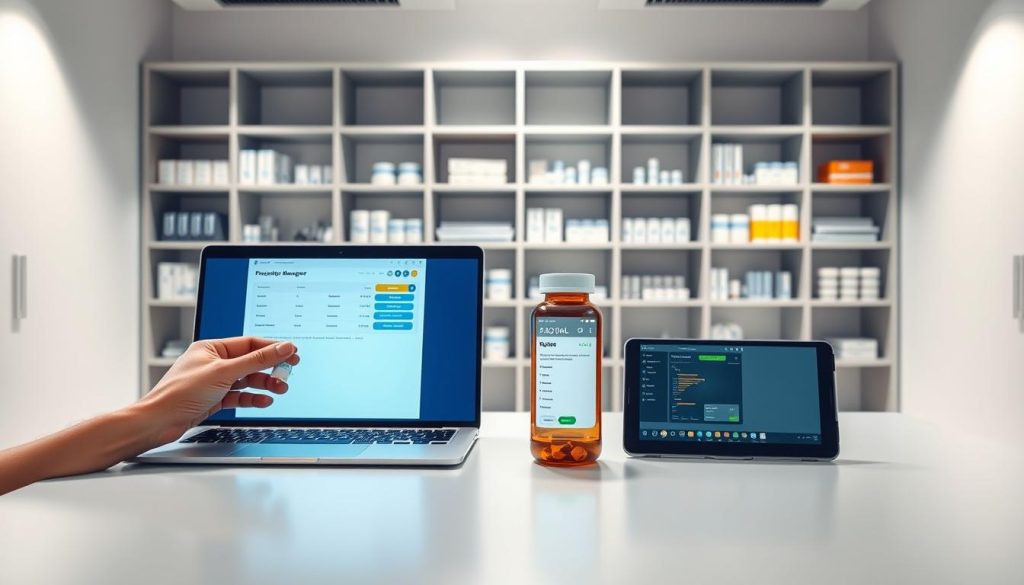Are you prepared for a future where your local pharmacy is not just a place to pick up prescriptions, but a hub for personalized healthcare and innovative services?
As we step into 2025, the pharmacy landscape is undergoing a significant transformation. Digital technologies are revolutionizing the way pharmacies operate, making services more accessible and patient care more personalized.
The integration of advanced technologies like AI and blockchain is poised to offer more efficient and secure services, enhancing patient care and streamlining pharmacy operations.
Key Takeaways
Table of Contents
- The future of pharmacy services is becoming increasingly digital.
- Innovations like AI and blockchain are enhancing patient care.
- Pharmacies are evolving into hubs for personalized healthcare.
- Digital health innovations are streamlining pharmacy operations.
- Patient care is becoming more accessible and secure.
How to Understand the Digital Transformation in Pharmacy
As we move into 2025, understanding the digital shift in pharmacy is crucial. The pharmacy landscape is undergoing a significant transformation, driven by technological advancements and changing patient needs. Digital pharmacy trends are not just about adopting new technologies; they’re about reimagining the way pharmacies operate and interact with patients.
The shift from traditional to digital pharmacy models is a key aspect of this transformation. Traditional pharmacies have long been the cornerstone of healthcare, providing essential services such as dispensing medication and offering health advice. However, with the advent of digital technologies, pharmacies are now able to expand their services beyond the physical storefront.
Tracking the Shift from Traditional to Digital Pharmacy Models
The transition to digital pharmacy models involves several key changes. Firstly, there’s the adoption of virtual pharmacy services, which allow patients to consult with pharmacists remotely. This not only enhances patient convenience but also expands the reach of pharmacy services.
| Traditional Pharmacy Model | Digital Pharmacy Model |
|---|---|
| Physical storefront | Online presence |
| Limited by location | Accessible from anywhere |
| Face-to-face consultations | Virtual consultations |
Identifying Current Technology Gaps in Your Pharmacy Practice
To successfully transition to a digital pharmacy model, it’s essential to identify current technology gaps. This involves assessing your pharmacy’s current technological capabilities and determining where improvements are needed. Key areas to focus on include online prescription management and the integration of digital tools into existing workflows.
By understanding these gaps, pharmacies can begin to address them, leveraging technologies such as AI-driven medication management systems and blockchain for prescription security. This not only enhances operational efficiency but also improves patient care.
Digital Pharmacy Trends 2025: What You Need to Prepare For
As we approach 2025, the pharmacy landscape is on the cusp of a significant transformation driven by digital innovations. Pharmacies must be prepared to adapt to these changes to remain competitive and provide high-quality patient care.
Implementing AI-Driven Medication Management Systems
The integration of AI in pharmacy is revolutionizing medication management. AI-driven systems can significantly reduce medication errors and improve patient outcomes by providing personalized care.
Steps to Evaluate AI Pharmacy Solutions
When evaluating AI pharmacy solutions, consider factors such as data accuracy, integration capabilities, and user experience. Ensure the solution is scalable and compliant with regulatory standards.
Integration Challenges and Solutions
Integrating AI systems can be challenging, but solutions such as API integrations and customized implementation plans can help mitigate these challenges.
Adopting Blockchain for Prescription Security
Blockchain technology is emerging as a critical component in enhancing prescription security. By creating an immutable record of prescriptions, blockchain can help prevent fraud and errors.
Developing Personalized Medicine Capabilities
Personalized medicine is becoming increasingly important, allowing for tailored treatment plans that meet individual patient needs. This approach can lead to better patient outcomes and more effective disease management.
By adopting these digital pharmacy trends, pharmacies can improve patient care, enhance operational efficiency, and stay ahead in the competitive landscape.
How to Leverage Virtual Pharmacy Services for Better Patient Care
Leveraging virtual pharmacy services can significantly enhance patient care by making healthcare more accessible. With the rise of telepharmacy innovations, patients can now receive professional advice and medication management from the comfort of their homes.
Setting Up Effective Telepharmacy Consultation Systems
Setting up telepharmacy consultation systems is a crucial step in providing patients with accessible care. These systems allow pharmacists to consult with patients remotely, reducing the need for in-person visits and improving patient outcomes.
Implementing Remote Medication Therapy Management Programs
Implementing remote medication therapy management programs is another way to enhance patient care. These programs enable pharmacists to monitor patients’ medication regimens and provide timely interventions.
Required Technology Infrastructure
A robust technology infrastructure is essential for remote medication therapy management. This includes secure and reliable telecommunication systems, electronic health records, and medication management software.
Compliance Considerations
Compliance with regulatory requirements is critical when implementing remote medication therapy management programs. Pharmacists must ensure that they adhere to HIPAA guidelines and other relevant regulations.
Training Staff on Virtual Patient Interactions
Training staff on virtual patient interactions is vital to ensure that patients receive high-quality care. Pharmacists and support staff must be trained to effectively communicate with patients remotely, using telecommunication tools and electronic health records.
| Key Components | Description | Benefits |
|---|---|---|
| Telepharmacy Consultation Systems | Remote consultations between pharmacists and patients | Improved patient accessibility, reduced wait times |
| Remote Medication Therapy Management | Monitoring and management of patients’ medication regimens | Enhanced patient adherence, improved health outcomes |
| Technology Infrastructure | Secure telecommunication systems, electronic health records | Secure data management, efficient patient care |
Steps to Modernize Your Prescription Management Systems
Modernizing prescription management systems is a critical step for pharmacies aiming to enhance patient care. As the healthcare landscape continues to evolve, pharmacies must adapt by leveraging technology to streamline their operations and improve patient outcomes.
The modernization process involves several key steps, starting with the assessment of current systems and identifying areas for improvement. This includes evaluating the efficiency of existing workflows, the security of patient data, and the integration of various technologies.
Selecting and Deploying Automated Refill Programs
One crucial aspect of modernizing prescription management is the implementation of automated refill programs. These programs can significantly reduce manual errors, improve patient adherence to medication regimens, and enhance overall efficiency. By automating the refill process, pharmacies can also reduce the administrative burden on staff, allowing them to focus on more critical tasks.
When selecting an automated refill program, pharmacies should consider factors such as ease of use, integration with existing systems, and the ability to customize notifications and reminders for patients.
Connecting Your Systems with Electronic Health Records
Another vital step is connecting pharmacy systems with electronic health records (EHRs). This integration enhances the continuity of care by ensuring that patient information is up-to-date and accessible to healthcare providers. EHRs also facilitate better coordination between different healthcare settings, reducing the risk of medication errors and improving patient safety.
To achieve seamless integration, pharmacies should work closely with EHR vendors to ensure compatibility and compliance with relevant healthcare regulations.

Developing Mobile Solutions for Patient Medication Management
Developing mobile solutions is a key component of modernizing prescription management systems. Mobile apps can empower patients to manage their medications more effectively by providing features such as reminders, dosage instructions, and refill notifications.
Essential Features for Pharmacy Apps
Pharmacy apps should include essential features such as secure patient authentication, easy access to prescription information, and personalized health insights. These features not only enhance the patient experience but also promote adherence to medication regimens.
User Experience Best Practices
To ensure the success of mobile solutions, pharmacies must prioritize user experience. This involves designing intuitive interfaces, minimizing the number of steps required to perform tasks, and ensuring that the app is accessible on a variety of devices.
By following these best practices and focusing on the development of user-friendly mobile apps, pharmacies can significantly improve patient engagement and medication management.
Preparing Your Business for E-Pharmacy Competition
As the e-pharmacy landscape continues to evolve, it’s crucial for pharmacies to prepare for the increasing competition. To stay ahead, pharmacies must invest in the right digital infrastructure, train their staff for a digital transformation, and develop effective digital marketing strategies.
Essential Digital Infrastructure Investments
Investing in the right digital infrastructure is critical for pharmacies looking to compete in the e-pharmacy space. This includes both hardware and software solutions that support online services and patient engagement.
Hardware Requirements
Pharmacies need to ensure they have the necessary hardware to support their digital operations. This includes secure servers, reliable internet connectivity, and digital kiosks for patient engagement.
Software Solutions
On the software side, pharmacies should invest in pharmacy management systems that can handle online orders, patient data, and inventory management. Other essential software includes telepharmacy platforms and patient engagement tools.
Staff Training Roadmap for Digital Transformation
A well-planned staff training roadmap is crucial for a successful digital transformation. This involves training staff on new systems, processes, and technologies to ensure they can provide high-quality virtual care.
- Training on pharmacy management systems
- Telepharmacy consultation skills
- Patient engagement strategies
Digital Marketing Strategies for Pharmacy Services
Developing effective digital marketing strategies is vital for reaching new patients and promoting pharmacy services in a crowded online marketplace. This includes search engine optimization (SEO), social media marketing, and email marketing.
- Identify target audience and create buyer personas
- Develop a content marketing plan
- Leverage social media to engage with patients
Conclusion: Embracing the Future of Pharmacy Technology
As we look to the future of pharmacy technology, it’s clear that embracing digital advancements is crucial for pharmacies to remain competitive. The integration of AI in the pharmaceutical industry is revolutionizing patient care, making it more personalized and efficient.
Online medication platforms are becoming increasingly popular, offering patients convenient access to their medications and healthcare services. Virtual pharmacy advancements are also enhancing patient interactions, allowing for more effective remote consultations and medication management.
To stay ahead, pharmacies must invest in the latest digital infrastructure, including automated refill programs and mobile solutions for patient medication management. By doing so, they can improve patient outcomes and streamline their operations.
The future of pharmacy technology holds much promise, and by staying informed and adapting to these changes, pharmacies can not only survive but thrive in a rapidly evolving landscape.


